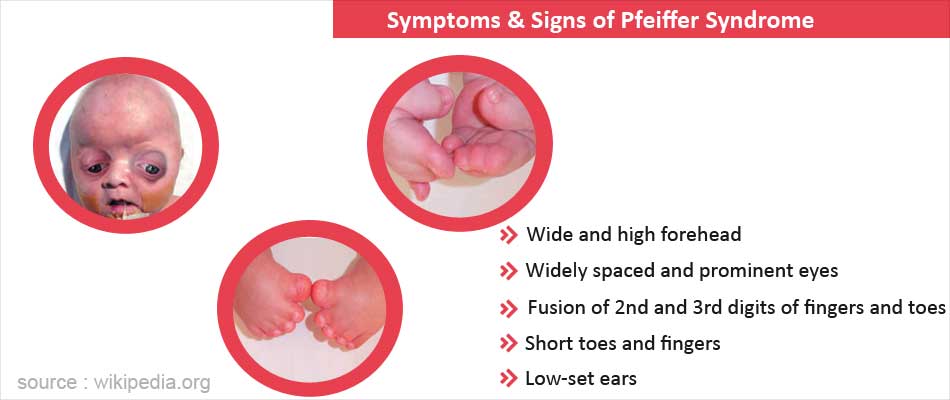- Pfeiffer Syndrome - (https://www.omim.org/entry/101600)
- About Pfeiffer syndrome - (https://ghr.nlm.nih.gov/condition/pfeiffer-syndrome)
What is Pfeiffer Syndrome?
Pfeiffer syndrome is a rare autosomal dominant genetic disorder that was first reported by Rudolf Arthur Pfeiffer (1931-2012). In 1964, Pfeiffer, diagnosed in 8 individuals from a family of 3 generations with the syndrome. In individuals with Pfeiffer syndrome, certain bones in the skull are fused together (craniosynostosis) affecting the shape of the face and head. In addition, individuals have fused feet and hands (syndactyly).
There are 3 types of Pfeiffer syndrome:
- Classic Pfeiffer syndrome (Type 1) – a mild condition with normal intelligence, normal neurological development, and an overall good prognosis with normal lifespan.
- Type 2 Pfeiffer syndrome – characterized with a cloverleaf skull and a poor outcome. Hydrocephalus (accumulation of cerebrospinal fluid in the brain) is a commonly observed neurological complication.
- Type 3 Pfeiffer syndrome – severity is intermediate between type 1 and type 2 syndromes. Cloverleaf skull is absent in this syndrome.
Premature death is characteristic of type 2 and type 3 Pfeiffer syndrome individuals.
What are the Causes of Pfeiffer Syndrome?
Pfeiffer syndrome is a genetic condition caused by different mutations either in the FGFR1 (chromosome 8) or FGFR2 genes (chromosome 10). The FGFR gene stands for the fibroblast growth factor receptor that provides the signal to cells in the embryo to develop and mature into bone cells. In the presence of a defective FGFR gene, cell signaling is disrupted causing irregularities in the development of the bone cells.
- Type 1 Pfeiffer syndrome – FGFR1 or FGFR2 mutations
- Type 2 Pfeiffer syndrome – FGFR2 mutation
- Type 3 Pfeiffer syndrome – FGFR2 mutation
Advanced age of fathers is one cause of Pfeiffer syndrome in the offspring. Type 1 Pfeiffer syndrome is the classic condition that is observed while types 2 and 3 syndromes are sporadic in nature.
There are possibilities of other genes being affected since certain individuals affected with Pfeiffer syndrome do not show mutations in either of the FGFR genes.
What are the Signs and Symptoms of Pfeiffer Syndrome?
Type 1 Pfeiffer syndrome is characterized by the following symptoms:
- Wide and high forehead and head is flat behind (occiput)
- Eyes are widely spaced and prominent due to shallow orbits
- Cheekbones are receded
- Nose is beaked
- Short and broad big toes and thumbs that are oriented away from the other digits
- Fusion of 2nd and 3rd digits (fingers, toes) - syndactyly
- Short toes and fingers (brachydactyly)
- Upper jaw is underdeveloped
- Dental complications
- Loss of hearing present in > 50% of children
- Mental retardation
- Obstruction to the nose and upper airways
- Low-set ears
- Abnormalities in vision
- Frequent infections
- Abnormalities in internal organs, such as kidneys and gallbladder
- Hydrocephalus
- Obstructive sleep apnea syndrome (OSAS)

Type 2 Pfeiffer syndrome is characterized by:
- Cloverleaf skull
- Abnormal stiffening and immobility (ankylosis) of the elbows
- Complications in neurological development
- Abnormalities in the toes and fingers
- Delay in development
- Improper positioning of the gastrointestinal system leading to gastroesophageal reflux or food that is consistently thrown up
Type 3 Pfeiffer syndrome is characterized by:
- Absence of cloverleaf skull
- Symptoms similar to type 2 Pfeiffer syndrome
- Improper positioning of the gastrointestinal system leading to gastroesophageal reflux or food that is consistently thrown up
How do you Diagnose Pfeiffer Syndrome?
Based on the clinical symptoms, it is possible to identify individuals affected with Pfeiffer syndrome. The main features of craniosynostosis and broad thumbs and big toes help to diagnose the condition.
X-ray analyses confirm abnormalities in the bones of the fingers and toes, skull deformities, and elbow ankylosis. If the ratio of the circumference of the big toe to that of the second toe is between 1.7 and 2.2, the condition can be diagnosed as Pfeiffer syndrome.
Differential diagnosis is a result of Pfeiffer syndrome being confused with Jackson-Weiss syndrome or Saethre-Chotzen syndrome because of the broad toes. In a similar manner, Antley-Bixler may be diagnosed instead of Pfeiffer syndrome.
There are other syndromes with similar features of craniosynostosis (e.g. Crouzon syndrome, Carpenter syndrome, Apert syndrome). Hence, it is recommended to perform genetic analysis to identify mutations in the FGFR1 and FGFR2 genes.
Genetic analysis is recommended in prenatal diagnosis, especially in cases where the diagnosis of Pfeiffer syndrome is not clear. It is important to conduct prenatal diagnosis to detect type 2 Pfeiffer syndrome with its characteristic cloverleaf skull. Fetal MRI and 3D- fetal ultrasonography are effective in identifying symptoms of the syndrome in babies. Prenatal diagnosis is vital for genetic counselors to identify parents who are at risk of having an affected offspring.

Cerebral MRI and transfontenellar ultrasonography are useful in diagnosing lesions in the cerebrum, including hydrocephalus.
How do you Treat Pfeiffer Syndrome?
There is no clear treatment for Pfeiffer syndrome. Surgical reconstruction is the best choice of treatment. Infants at 3 months of age are treated with surgical reconstruction where the skull is remodeled and the brain is decompressed. These reconstruction surgeries are required as the child grows.
If the treatment begins early, there is a reduced risk of complications, such as hydrocephaly. Other surgeries are also required to correct the eye orbit spacing. In cases with widely spaced eyes and shallow orbits, individuals are prescribed lubricants at night and artificial tears during the day.
Multidisciplinary or collaborative care is vital in managing Pfeiffer syndrome. Collaboration is essential between specialists in plastic surgery and orthopedics, pediatricians, neurosurgeons, ophthalmologists, and neonatologists.







